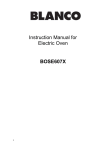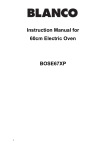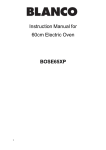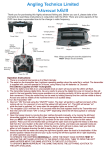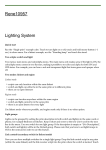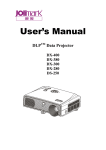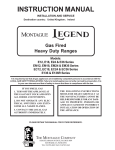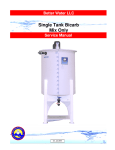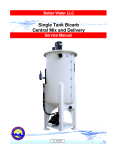Download BOSE714PTX User Manual
Transcript
Instruction Manual for Pyrolytic Oven BOSE714PTX 1 Dear Customer, Thank you for buying a BLANCO oven. Before we continue telling you about this oven, we cordially invite you to become part of the Blanco family by subscribing online. Please visit our website where you can easily register for product/cooking demonstrations, and request Blanco’s gourmet recipes. Go to www.blanco-australia.com and fill in the subscription details in the contact us/showrooms section. You will find that the clean lines and modern look of your Blanco oven blends in perfectly with your kitchen décor. It is easy to use and performs to a high standard. Blanco also makes a range of products that will enhance your kitchen such as cooktops, rangehoods, dishwashers and microwaves, sinks and taps. There are models to complement your new Blanco oven. Of course, we make every effort to ensure that our products meet all your requirements, and our Customer Relations department is at your disposal, to answer all your questions and to listen to all your suggestions. Please complete the warranty card and keep your receipt as proof of purchase. Retain all documents relating to the purchase of this product. Blanco is committed to providing increasingly efficient products that are easy to use. Table of Contents Safety Instructions Warnings Use Maintenance and cleaning 4 4 4 5 Installation of the oven 6 Electrical Installation 8 Oven Racks 9 Accessories 12 Cooking functions 13 Electronic Control 14 Door Locking System 21 Cleaning and Maintenance 22 Oven Door Removal 23 Replacement of the Oven Light 24 Guidance Temperature and Time Temperature for Cooking 25 Cooking Recipes 26 3 Safety Instructions Important - When you receive the appliance, unpack it or have it unpacked immediately. - Give it an overall inspection. Make note of any concerns or reservations on the delivery slip and make sure to keep a copy of this form. Keep this user guide with your appliance. - If the appliance is ever sold or transferred to another person, ensure that the new owner receives the user guide. Please become familiar with these recommendations before installing and using your oven. They were written for your safety and the safety of others. WARNING - The Appliance is not intended for use by persons (including Children) with reduced physical, sensory or mental capabilities, or lack of experience and knowledge, unless they have been given supervised instruction concerning use of the appliance by a responsible person for their safety. - Cleaning and maintenance operations must not be carried out by children without supervision. - Children must be supervised to prevent them from playing with the appliance. WARNING - During use the appliance becomes hot. Care should be taken to avoid touching heating elements inside the oven. - Accessible parts will become hot when in use. To avoid burns and scalds, young children should be kept away. Use - Before using your oven for the first time, heat it while empty for approximately 15 minutes. You should ensure you heat each element in the oven before use. Make sure that the room is sufficiently ventilated. You may notice a particular odour, or a small release of smoke. All of this is normal. Your appliance is intended for standard household use. Do not use it for commercial or industrial purposes or for any other purpose than that for which it was designed. This oven was designed for use by private individuals in their homes. It is intended solely for cooking foodstuffs. This oven does not contain any asbestos-based components. - Do not modify or attempt to modify any of the characteristics of this appliance. This would be dangerous to your safety. - Never pull your appliance by the door handle. - When placing dishes inside or removing them from the oven, do not place your hands close to the upper heating elements and use heat-protective kitchen gloves. - At the end of cooking, do not pick up oven or grill items (grid) with your bare hands. - Never place aluminium foil directly in contact with the floor of the oven, as accumulated heat may cause deterioration of the enamel. - Do not place heavy weights on the open oven door, and make sure that children are able neither to climb nor sit on it. - Do not use your oven as a larder or to store any items after use. - After using your oven, make sure that all the controls are in their stop position. - In addition to the accessories supplied with your oven, only use dishes capable of withstanding high temperatures. Maintenance and cleaning - Do not use a steam cleaner. - For any cleaning operation inside the oven cavity, the oven must be switched off. - Before unclipping the door, allow the appliance to cool. - Before removing the back, ensure that the appliance is powered down. After cleaning, the back should be replaced. - Do not use harsh abrasive cleaners or sharp metal scrapers to clean the oven glass door since they can scratch the surface, which may result in shattering of the glass. - To clean both the electronic programmer window and the oven door, use a soft cloth. - Do not use cleaning products, abrasive creams, or scouring sponges. WARNING - Make sure the appliance is disconnected from the power before replacing the lamp in order to avoid the risk of electric shock. - Change the lamp only when the appliance has cooled down. To unscrew the view port and the light, use a rubber glove, which will make disassembly easier. WARNING - Installation should only be performed by qualified installers and technicians. WARNING - If the electrical supply is restricted, means of all-pole disconnection must be accessible and incorporated in the fixed wiring in accordance with the wiring rules. If the power cable is damaged, it should be replaced by the manufacturer, its after-sales service department or by a similarly qualified person in order to avoid danger. PACKAGING - This appliance’s packing materials are recyclable. Recycle them by depositing them in local authority containers provided for this purpose. - Your appliance also contains many recyclable materials. It is therefore marked with this logo to indicate that used appliances must not be mixed with other waste. 5 Installation of your oven To install the oven into the kitchen a cutout should be made in accordance with the dimensions shown below. Please allow for 3/ 4mm of a difference in the dimensions provided below. Please measure the original product to ensure that the cut out details are correct. The apparatus is to be fastened to the top by means of the two screws provided in the kit through the holes made on the oven uprights. The cabinet in which the apparatus is installed shall be open on the back side to ensure a sufficient air circulation and prevent overheating. Leave a gap of at least 200 cm2 (see Fig. 1) for air circulation if the oven is installed in a column; this is not necessary if the oven is installed under the work top. WARNING As the apparatus is to be fitted in your kitchen furniture, make sure that all surfaces in contact with the oven can resist a temperature of approx. 90°C. Overall product Dimensions 585 mm Height 750 mm Width 565 mm Depth 7 Electrical Installation BOSE714PTX is 15 Amp with cable supplied. There is no plug supplied. It requires hard wiring by a qualified electrician. WARNING This apparatus must be earthed. The oven is only for domestic use. The feed voltage and the absorbed power are as indicated on the data plate attached to the left-hand side upright, which can be seen when the oven door is open. Connecting must be carried out by qualified personnel and in accordance with the regulations currently in force. The manufacturer cannot be held responsible for any damages to persons or objects caused by failure to observe these instructions. If the supply cord is damaged, it must be replaced by the manufacturer, its service agent or similarly qualified persons in order to avoid a hazard. The oven must be connected to the mains through a multiple circuit breaker with a contact-to-contact gap of at least 3 mm, making sure that the earth wire is not disconnected. For connecting use a flexible cable of the H05V2V2-F 3x1,5 mm2 type remembering to make it long enough to allow the oven to be removed from its housing unit when maintenance work is required. To connect the cable to the oven, proceed as follows: - Remove the lid by unfastening the three screws. - Unfasten the two screws for the cable holder and feed the cable through the opening immediately below the cover. - Remove about 12 cm of the outside insulation from the cable and shorten the two active wires (live and neutral) to 6 cm, leaving long the one to be connected to the main earth terminal on the terminal box; remove about 1 cm of the main insulation from the three wires and connect them correctly to the terminal box, Remembering to respect the polarities. - Tighten the two screws of the cable holder and put the lid back on with the three screws. Electrical Specifications - Absorbed power: Grill element Oven bottom element: Fan forced element: Roasting jack motor: 3500 W 2100 W 2500 W 4W Lamp: 25 W Hot air fan motor: 20 - 25 W Cooling fan motor: 25 W - Maximum absorbed power: (see data plate). - Supply voltage: (see data plate). Oven Racks WARNING Never use aluminum foil to cover the oven racks or to line the oven. It can cause damage to the oven liner if heat is trapped under the foil. WARNING Make sure you do not force it to avoid damage to the enamel. The oven has rack guides at four levels. Rack positions are numbered f r o m t h e bottom rack guide (#1) to the top (#4). Check cooking charts for best rack positions to use when cooking. Each level guide consists of paired supports formed in the walls on each side of the oven cavity. Always be sure to position the oven racks before turning on the oven. Make sure that the racks are level once they are in position. The racks are designed to stop when pulled forward to their limit. Fig 3 To remove oven rack from the oven (see Fig. 4): 1 Pull rack forward. 2 Lift rack up at front and then remove it. 1 2 Fig. 4 9 To replace an oven rack (see Fig. 5): 1 Place rear of rack between rack level guides. 2 While lifting front of rack, slide rack in all the way while lowering the front. 1 2 2 . Fig. 5 Extendable Telescopic Racks 2 of the racks in this oven are fully extendable telescopic racks and therefore these racks easily slide out when used, which allows for easy convenience. The extendable rack allows for easier access to cooking foods. It extends beyond the standard flat rack bringing the food closer to the user. WARNING Make sure that: - - When the rack is outside of the oven, slide arms do not lock. They could unexpectedly extend if the rack is carried incorrectly. Extending slide arms could cause injury. Rack should only be held or carried by grasping the sides. To avoid burns, pull rack all the way out and lift pan above handle when transferring food to and from oven. NOTE Always remove the extendable rack before self-cleaning the oven. To remove extendable rack from the oven (see Fig. 6): 1 Lift of rack slightly and push it until the stop release. 2 Raise back of rack until frame and stop clear rack guide. 3 Pull rack down and out. 1 2 3 Fig. 6 To replace an extendable rack (see Fig. 7): 1 Grasp rack firmly on both sides. Place rack (Including frame) above desired rack guide. 2 Push all the way in until the back of the rack drops into place. 3 Pull both sections forward until stops activates. Rack 1 should be straight and flat, not crooked. 1 2 Fig. 7 11 Accessories Accessories which are provided with this oven are as follows: - 2 x safety anti tip shelves - 2 x grill pan - 1 x grill pan insert - 1 x grill handle - 2 x fully extendable telescopic runner Cooking Functions Each type of oven is provided for various cooking systems. The light is on only. --- In this mode only the internal oven convection fan is ON i.e. there is no oven heating This mode is used to defrost deep frozen food. Only the lower (bottom) oven heating element is activated. This mode is used to keep foods warm. In this mode both upper (top) and lower (bottom) oven heating elements are used to heat the oven air. However, no fan is used to circulate the heat. This is the traditional mode of cooking on one shelf. Therefore only one rack can be used when selecting the Bake mode. Ideal for Appetizers, Biscuits, Coffee Cakes and Cookies. This mode is intended to save energy. In particular the oven cooling fan works only when needed e.g. when the oven is hot and the electronics require cooling. Ideal for frozen or precooked food, and small portions-meals. The preheat time is very short and cooking tends to be slower. It is not recommended for heavy loads e.g. large portions or big meal preparation. The Convection bake mode uses the upper (top) oven heating element, the lower (bottom) heating element and the convection fan inside the oven. It can also be used for baking-cooking Appetizers, Biscuits, Coffee Cakes and Cookies on one or more levels. The Convection Roast( extra hot intense mode ) mode uses the Intense upper (top) oven heating element, the lower (bottom) heating element and the convection fan inside the oven. Ideal for the roasting of whole chickens or turkey. The True Convection Bake mode uses the circular or third heating element hidden behind the baffle at the back wall of the oven. The heat is circulated throughout the oven by the convection fan. Consequently different foods can be cooked simultaneously (maximum three levels) and is suitable for preparing a complete dinner (small portions). Mixing of flavours is avoided and an important energy saving is obtained. The Ring + Down Convection mode uses the lower + circular heating elements and internal fan. Useful for multi-level cooking of soufflés and pizzas. The Convection Down mode uses the lower (Bottom) heating element and internal fan. Useful for soufflés, pizzas and pastry dishes. Suitable for preparing a complete dinner (small portions). Mixing of flavours is avoided and an important energy saving is obtained. Ideal for steak, hamburgers, chicken quarters or chicken breasts. The Grill mode uses intense heat radiated from the upper (top) heating element. Ideal for preparing toast, browning and grilling. The standard time is 1.30 h and can be changed. ( see page 17) PYRO or self-cleaning mode. Here the oven is automatically cleaned by burning-off cooking residues at high temperature (about 475 °C) from 1h to 3h. During the self-cleaning cycle all fumes produced are filtered and then expelled to ambient. 13 Electronic Control Control panel description The oven control panel is made by three displays and eight touch sensor keys. Please note that the display drawings below are not exactly the same as the final product however the working is the same. The display shows the following: > Time. > Temperature. >Function. c m in A B C D E F G H Fig. 8 >[A] Touch this key to enable the fast preheat >[B] This key is used to set the clock, the minute minder and the buzzer volume. >[C] This key is used to set the cooking duration and the stop time. >[D] Touch or hold this key in order to decrease the displayed value. >[E] Touch or hold this key in order to increase the displayed value. >[F] Touch this key to switch the oven lights on/off. >[G] This key is used to set the oven functions and the related temperature. >[H] Touch this key in order to switch the oven on and make it available for any activity or touch it to switch the oven off when it’s active. Power-up At every power-up, wait for about 7 seconds until a triple beep sounds: the special touch circuit performs a selfcalibration and it’s important to avoid any touch during this phase. The latch mechanism runs an automatic self-test: the oven door locks and unlocks. This operation takes about half a minute. The lock symbol on the temperature display turns on: 1. It flashes while the action is in progress. 2. it’s steadily on when the door is fully locked. 3. it’s off when the door has been unlocked. Do not try to open the door until the lock symbol has disappeared. The control shows the time of day blinking set at 12:00 as the initial value. The time increases every minute, all oven operations are inhibited until the time of day is set. Setting the time of day The time of day is always displayed in the 24 hours format. Touch the [B] key (clock/timer) until the word “hour” appears on the clock display. Wait until the time value appears then touch [D]/[E] keys in order to set the proper value. Hold the keys to fasten the decrease/increase operations After a few seconds the whole time of day value starts flashing: wait until the new time of day is steady. Fig. 9a Setting the minute minder Touch the [B] key (clock/timer) until the word “bell” appears on the clock display. Wait until the time value appears again then touch or hold [D]/[E] keys to edit and modify the value. Hold the keys to fasten the decrease/increase operations. The standard value is 30 minutes, it’s possible to modify it in the range between 0 and 240 minutes. The timer has no influence on the oven activities and can be set also when the oven is off. The time of day is displayed with priority in any case, the bell symbol in the upper left corner of the clock display shows that the minute minder is set. When the time expires, the symbol flashes and the buzzer sounds a warning sequence (two short beeps repeated every 3 seconds) to recall the user attention. Touch any key to stop it. The buzzer stops in any case after a 5 minutes time-out. Setting an oven function manually 1. Touch the [H] key (On/Off) to awake the oven and make it ready for use. A square appears on the icon display and the “On” writing on the clock display. 2. Touch the [G] key (function/temperature) in order to select the desired cooking mode. The clock display shows “Pr00” which correspond to the Light mode. 3. Touch [D] or [E] keys (-/+) in order to browse the list of the available functions. The icon display shows the oven elements used in every function; the temperature display shows the preset temperature per every function. 4. Touch the [G] key again in order to change the temperature. The temperature starts flashing on its own display, touch [D] or [E] keys (-/+) in order to select the desired value, in a range between a minimum and a maximum, depending on the mode. Check the value on the temperature display. 5. Touch the [G] key once more to confirm the selection otherwise it will be confirmed automatically after a short time. 6. Once the mode is selected, touch [A] key (booster) if you need to fasten the oven preheat. Normally the food must be introduced after the end of preheat in this case. The oven will work until a maximum time 12hours. Depending on the oven model, the number and type of available functions can be different. 15 If the selected function works using any heating elements, the symbol is displayed (it doesn’t appear in defrost position). c min Fig. 9b As soon as the oven starts, the preheat bar on the temperature display turns on, step by step, showing when the oven is at 25%, 50%, 75% and finally 100% of the set-point. As soon as each level is reached, its step becomes steady, the next one start flashing. All the four segments become steadily on when the preheat ends. Fig 9c The icon display shows the oven elements in use (heaters, working fan, turnspit) whenever any function is active. Touch the [H] key (On/Off) to stop any oven activity immediately. The “OFF” writing appears on the clock display. Setting an automatic oven function After having selected a function as described before, the control can be programmed in order to set timed cooking activities. The time program remains active even if the function is changed (exception: pyrolysis). The following options are available: 1. Timed cooking setting the cooking time (duration). 2. Timed cooking setting the end of cooking time (stop time). 3. Delayed cooking setting duration and stop time. Touch the [C] in order to toggle between cooking duration (cook time) and end of cooking time (stop time): the words “dur” or “End” are displayed respectively. Touch [D] or [E] keys (-/+) to edit the duration or the stop time when the proper word is displayed: 1. When the word “dur” is displayed, the control shows 30’ as the standard cooking duration. Touch [D] or [E] in order to set the actually desired cooking time in a range between 0 and 240 minutes. As soon as the value is accepted the display switches to clock mode. It will show the time of day, the pot symbol and the letter to indicate that a timed cooking is active. The end of cooking time is updated automatically. 2. When the word “End” is displayed, the control shows the current time as the initial stop time. In order to set the actually desired end of cooking time in a 24 hours range. As soon as the value is accepted the display switches to clock mode. It will show the time of day, the pot symbol and the letter to indicate that a timed cooking is active. The cooking time is updated automatically. 3. Repeat the same operations of point 1 then touch [C] k e y until End appears. The control shows the “current time + cooking time” as the initial stop time. It’s not possible to lower the end of cooking time below this value. Touch [D] or [E] keys (-/+) in order to set the actually desired end of cooking time in a 24 hours range. The display will flash End and its value alternatively for a few seconds then it will show the time of day and the letter to indicate that a delayed cooking has been programmed. As soon as the delay time expires, the oven starts and works for the programmed cooking time. The symbol is displayed. At the end of any timed activity the control shuts down the oven, the buzzer sounds a warning sequence (two short beeps repeated every 3 seconds) to recall the user attention, for a maximum time of 5 minutes and makes the time related icons ( , )flash on the display. Touch any keys to silent the buzzer and reset the warning message. The buzzer doesn’t sound between 22:00 and 8:00 (night mode). Touch the [H] key in order to stop any activity. Oven functions The control can manage many cooking functions, their number and availability depends on the oven model. The temperature range is between 75°C and 250°C for most functions. Preset temperatures are mainly 190°C for convection modes, 210°C for thermal modes and 230°C for grill functions. Exceptions are Eco-Bake (preset=190°C), Pyrolyse (fixed 475°C), and warming mode which range is between 50°C and 120°C. Booster (Fast Preheat) This function allows one to fasten the oven preheating, saving time. When the oven temperature reaches the setpoint a continuous acoustic warning signal, about 5 seconds long, recall the attention of the user. Fast Preheat is not available in Grill, Pyrolyse, Eco- Bake, Keep Warm and Defrost. Touch [A] key to enable the function, the writing “Prh” appears on the clock display, the “°C” symbol on the temperature display flashes until the oven reaches the set temperature. Eco-Bake This function is defined in order to obtain a consistent energy saving. The cooling fan is initially off and turns on only when the inner parts temperature gets high, then it works with the heating elements. Cooking might be a little bit slower than the standard Bake, especially when the oven is heavily loaded. When this function is active, the writing “Eco” flashes every 5 seconds on the temperature display. Defrost This function is used to defrost frozen food in a short time. It doesn’t heat up the oven, only the convection fan works. The temperature display shows dEF to indicate that this special mode is active. Pyrolyse (Self-Clean) 9 VariPyro) You can choose to set the pyro oven to clean between 1 and 3 hours. Select the proper program to start a cleaning cycle. The temperature display show the writing -P- and the icon display shows the elements in use. The clock display starts showing “Pyro” for a few seconds. The clean time can be set according to the same rules of the automatic functions, and therefore the pyrolitic cycle can be delayed. The maximum allowed clean time is 3 hours, the minimum 1 hour. The standard time is 1h:30 min, the clock display shows P1:30. At the end of the self-cleaning activity the display shows “---“ steady and flashing as long as the oven is cooling and the door remains locked. Once the oven is cool enough, the door unlocks and the 17 display shows “End”. Touch [H] key in any moment to stop the oven. The door remains locked until the oven temperature drops below the safety threshold, at this time the control unlocks the door. The cooling fan starts as soon as the function is selected and turns to its higher speed when the inner parts get hot. The oven temperature is automatically set to 475°C in order to perfectly clean the cavity. c min Fig 9d The control also locks immediately the door in order to guarantee the user safety, given that the temperature inside gets very hot. A lock icon on the temperature display shows the status of the latch mechanism at any time: > Door unlocked, lock symbol off. > Door locked, lock symbol always on. > Latch moving, transition in progress, lock symbol flashing. Eco-Pyrolyse When this function is active, the writing “Eco” flashes every 5 seconds on the temperature display. The standard time is 1h:30 min and can never be changed, the clock display shows P1:30. It is used in case a light cleaning action is requested. Door and commands lock for children safety (pyro) This is an additional safety functions. The door latch mechanism, managed automatically during pyrolyse can be actuated manually by the user in order to lock the oven door and prevent children from having free access to the oven. Hold and keys simultaneously for about 3 seconds to lock/unlock the door manually. Also the keyboard is disabled while this function is actuated: the display shows a key on the clock display in case of any attempt to touch inactive keys. Buzzer volume The buzzer volume can be set, when the control is in stand-by mode, touching first the [B] key until the writing “L1”, ”L2” or ”L3” is displayed (depending on the set volume) then touching the [D]/[E] key. At any touch the buzzer sounds a double beep, selecting the volume out of three available levels. Night mode This mode is active between 22:00 and 8:00 overnight. During this period, the buzzer is always silent and the background blue light of the clock display reduces its brightness. Touching any keys will not cause any acoustic feedback. Failure declarations and error codes The control is continuously checking the status of the system. If an abnormal condition is detected for more than 1 minute, a failure occurs: - The heaters and the other loads are disabled. - The display shows a “E” letter flashing, followed by a numeric code that depends on the kind of failure. - The control emits an acoustic warning signal that will last for some minutes. To reset a failure declaration, first remove the cause of the failure then touch the [H] key (OFF). Error code table. 19 Error Description E001 Temperature sensor shorted. E008 Latch time-out overflow. E016 Oven cavity overheating E017 Temperature sensor disconnected or broken E032 Wrong oven model configuration Cooking mode table with preset, minimum, maximum temperatures (°C) and nominal power (Watt) MH04 MH03 MODE T MIN (°C) PRESET (°C) T MAX (°C) HEATING ELEMENTS (W) NAME Pr00 Pr00 # # # LIGHT Pr01 Pr01 # # # DEFROST Pr02 Pr02 50 75 120 2870 KEEP WARM Pr03 Pr03 120 190 250 3350 ECO-BAKE Pr04 Pr04 120 210 250 3350 BAKE Pr05 Pr05 75 190 250 3350 CONVECTION BAKE Pr06 Pr06 75 190 250 3350 CONVECTION ROAST Pr07 Pr07 75 190 250 2870 LOWER CONVECTION Pr08 Pr08 75 190 250 3350 CONVECTION GRILL Pr09 Pr09 L1 L2 L3 3350 GRILL Pr10 NA 75 190 250 2300 TRUE CONVECTION BAKE Pr11 NA 75 190 250 2300 SPECIAL (RING + LOWER) Pr12 Pr10 475 3350 ECO PYRO Pr13 Pr11 475 3350 PYRO Prh Prh C° VARIOUS FAST PREHEAT Door Locking System Automatic door locking during pyrolytic cycle For safety reasons, the door is locked automatically as soon as self-clean mode is selected (both standard, both eco clean). The door is also unlocked automatically when the clean time has expired but only after the temperature has fallen below the safety threshold. NOTE It is not possible to exclude the door locking device during self- cleaning i.e. manually unlock the door since the self-cleaning mode has the highest priority and overrides all other selections. The lock symbol ( ) on the display is: ON When the door is fully locked OFF When the door is fully unlocked FLASHING When the latch mechanism is moving. (After self-clean the symbol will flash until the temperature will be safe and the door unlocked). Opened door When the door is opened the door lock mechanism is not energized and consequently it does not run. 21 Cleaning and maintenance Prior to taking any action for cleaning, make sure the apparatus is cut-out from the mains. It is recommended that the oven interior be frequently cleaned. In particular, it should be cleaned every time the grill is used to prevent excessive fouling of the oven interior that may generate fumes or odours during subsequent cooking. Abrasive detergents and steam cleaning equipment should not be used for cleaning. WARNING Do not use harsh abrasive cleaners or sharp metal scrapers to clean the oven door glass since they can scratch the surface, which may result in shattering of the glass. Ovens provided with the hot air system are less subject to dirt inside. Self-cleaning cycle (pyrolytic cycles) Although it is not necessary to perform the cleaning operation each time the oven has been used, do not let the oven get too dirty. It is average to so a pyro clean 4 times a year. However this depends on how often you use your oven. Before performing self-cleaning, take out all accessories (grills, dishes, pans) to avoid damaging them, remove large cooking residues and then close the door, ensuring that it is closed properly. WARNING Ensure that the door is in the closed position before the self- cleaning cycle starts, otherwise automatic door locking will not be completed. When the cycle is finished and the oven has COOLED COMPLETELY, remove the burned-off residues of the self-cleaning cycle with a damp cloth. Oven door removal WARNING - The oven is cool and power to the oven has been turned off before removing the door. Failure to do so could result in electrical shock or burns. - The oven door is heavy and fragile. Use both hands to remove the oven door. The door front is glass. Handle carefully to avoid breakage. - Grasp o nly the sides of the oven door. Do not grasp the handle as it may swing in your hand and cause damage or injury. - Failure to grasp the oven door firmly and p roperly could result in personal injury or product damage. To remove the oven door (see Fig. 10): 1 2 3 4 5 Open the door completely. Lift up the hinge bracket (1) into the slot (2). Hold the door firmly on both sides using both hands and close the door. Hold firmly; the door is heavy. Place the door in a convenient location. To replace the oven door (see Fig. 10): 1 Insert the upper arms (3) of both hinges into the upper slots (6) and the lower arms (4) into the lower slots (7). The recesses (5) must hook on the lips (8). 2 Move the hinge brackets (1) back down into position. 3 Close and open the door slowly to assure that it is correctly and securely in place. Fig. 10 23 Replacement of the oven light WARNING - - The oven and lights are cool and power to the oven has been turned off before replacing the light bulb(s). Failure to do so could result in electrical shock or burns. The lenses must be in place when using the oven. The lenses serve to protect the light bulb from breaking. The lenses are made of glass. Handle carefully to avoid breakage. Broken glass could cause an injury. 1. Turn off power at the main power supply (fuse or breaker box). 2. Remove the lens (1) by unscrewing it. 3. Remove the light bulb (2) from its socket (3). 4. Replace the bulb (2) with a new one. Avoid touching the bulb with fingers, as oils from hands can damage the bulb when it becomes hot. 5. Use one with the same Volt and Watt (see Fig. 11). 6. Screw the lens (1) back on. 7. Turn power back on at the main power supply (fuse or breaker box). Guidance Temperature and Time Schedule for Cooking FOOD Mode Traditional cooking Rack position (from the bottom) Temperature °C Cooking time in minutes Hot-air cooking system Temperature °C Cooking time in minutes Pork, calf (roast) etc. 3th 180 ÷ 190 25÷ 35 170 ÷ 180 20 ÷ 30 Pork ,calf (roast) etc. 3th L3 25÷ 35 215 ÷ 230 20 ÷ 30 Fillet, roast beef 2nd 170 ÷ 180 30 ÷ 35 165 ÷ 170 25 ÷ 30 Poultry (goose, duck, turkey chicken) whole (2) 2nd 200 ÷ 210 18 ÷ 22 190 ÷ 200 15 ÷ 18 Chicken quarter, hamburger, ,steak 3th -- -- 220 ÷ 230 12 ÷ 14 for each side Game (2) 3th 180 ÷ 190 45 ÷ 75 170 ÷ 180 40 ÷ 70 Fish 3th 200 ÷ 210 30 ÷ 35 180 ÷ 190 25 ÷ 30 Cakes 2nd 190 ÷ 200 40 ÷ 50 170 ÷ 180 35 ÷ 40 Biscuits 2nd 175 ÷ 185 10 ÷ 15 165 ÷ 175 7 ÷ 13 Pizza (fresh) 2nd 215 ÷ 225 15 ÷ 18 -- -- Pizza (frozen) 2nd 200 ÷ 210 25 ÷ 30 -- -- -- -- 200 ÷ 220 12 ÷ 15 -- -- 190 ÷ 200 23 ÷ 26 L3 4÷6 -- -- Pizza multilevel (fresh) 2nd & 4th or 1st &3th Pizza multilevel (frozen) Bread toast 3th Warning for hot-air cooking - Position of pans: - For cooking on 1 plane make use on 2nd holder from the bottom; using - For cooking on 2 planes make use of 2nd - 4th holders from the bottom; using - For cooking on 3 planes make use of 2nd - 3th and 4th holders from the bottom; using - (2) The time depends of poultry dimension, (40 ÷ 45 mins for kg). IMPORTANT The cooking times are considered with oven preheated. 25 Cooking Recipes Beef Wellington Preheat oven to 180-190°C on Fan Assist or 200ºC on Fan Forced Ingredients: 2 tablespoons extra virgin olive oil 4 pieces of beef fillet (150g each) 2 tablespoons brandy 150g mushrooms, finely chopped 2 tablespoons chopped spring onion 4 sheets puff pastry 4 tablespoons fresh breadcrumbs 50g chicken liver pate- Optional 1egg yolk, beaten, to brush Method: Heat olive oil in frying pan over high heat, add beef fillet and sear quickly on both sides, pour brandy over beef and quickly light for flaming effect. Once extinguished transfer beef to plate lined with paper towel and set aside to cool. Heat remaining oil in pan and add mushrooms and spring onions. Cook over medium heat for 1-2 minutes. Lay out pastry sheets and sprinkle some breadcrumbs in the centre of each. Place the beef on top of pastry; the breadcrumbs absorb any excess juice. Top the beef with a slice of pate and some mushroom mixture. Fold up the pastry to enclose, and trim any excess. Press pastry edges together and garnish with any pastry trimmings. Brush with egg yolk and transfer to lightly greased oven tray. Bake in the oven for about 18 minutes or until the pastry is golden. Berry and Ricotta Tart Preheat oven 170-180 ‘C on Bottom Element and Fan. Ingredients: Pastry Filling 125g butter, chilled and cubed 200g fresh ricotta 1 egg lightly beaten ½ cup cream 1/3 cup icing sugar 2 eggs ½ cup group almonds 2/3 cup castor sugar 1 ½ cup plain flour ½ cup raspberries ½ cup blueberries 1 teaspoon vanilla extract Method: Grease a 26cm tart tin Place flour, icing sugar, almonds and butter into a food processor and process until mixture just comes together. Alternately rub the butter into the dry ingredients until it resembles fine breadcrumbs, add egg and stir until the mixture comes together. Turn onto a floured surface and gather into a ball. Wrap in plastic wrap and refrigerate for 30 minutes. Roll out the pastry between two pieces of baking paper. Roll out to fit the base and sides of the tin. Trim away any excess pastry and refrigerate pastry case for 30 minutes. Mix ricotta, vanilla, egg, sugar and cream in a food processor until smooth. Fill chilled pastry case with ricotta mixture and sprinkle berries gently over filling. Place in preheated oven for 30-35 minutes Cool and dust with icing sugar to serve. NOTE: Pastry will make enough for two cases. Either bake both cases and leave in an airtight container for up to a week, or freeze half the uncooked dough for up to two months. 27 Mediterranean Pizza Preheat oven to 180’ C on Fan Forced. Method: Bake for 15-20 min Ingredients: 1 uncooked Pizza Base Marinated artichokes 2 tablespoons of pasta sauce Kalamata olives Chargrilled eggplant Sundried tomatoes Chargrilled capsicum Zucchini diced 1 cup pizza cheese Mushrooms sliced 2 tablespoons parmesan cheese Onion diced 2 tablespoons fresh rosemary Roma tomato diced Method: Start with placing the sauce on base pizza and then add the cheese. Layer vegetables on the pizza base. Sprinkle cheese and herbs on top of the vegetables. Cook for approximately15-20 minutes or until base is crisp and cheese has melted. Serve with fries or salad. Spinach, Ricotta and Goats Cheese Muffins Pre heat oven to 170°C on fan forced. Ingredients: 30g butter 1 cup milk 70g baby spinach 1 ½ cups plain flour 1 tablespoon baking powder 1 tablespoon chopped rosemary 1 tablespoon chopped chives 1 garlic clove crushed 2 tablespoons parmesan cheese (finely grated) 150g goats cheese fetta 1 egg, lightly whisked ¼ cup olive oil 8 Cherry tomatoes Salt and Pepper to taste Method: 29 Line a muffin tray with 8 muffin paper cup holders and lightly spray with cooking oil In a large bowl sift flour , bicarb-soda and baking powder together and set aside In a medium size fry pan, melt butter and add baby spinach, garlic, fresh herbs, salt and pepper and milk. Cook on a medium heat until baby spinach has wilted and set aside to cool, once cooled, blend spinach mixture until spinach leaves are finely chopped Mix ricotta, goats cheese and parmesan until combined. Add all cheeses, whisked egg, olive oil and spinach mixture to flour and stir until combined Fill muffin cups to ¾ full, slightly push a cherry tomato in the centre and place in oven for approximately 16 minutes Serve warm We appreciate your feedback. Please review our products on www. blanco-australia.com






























